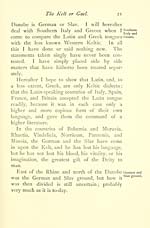Blair Collection > Kelt or Gael
(24)
Download files
Complete book:
Individual page:
Thumbnail gallery: Grid view | List view

20 The Kelt or Gael.
the Romans. They are best known to Western.
Europe from St Paul's Epistle to the Galatians.
St Jerome, a Gaul who lived at Treves, visited
them in the beginning of the fourth century of our
era, and says the Galli of Asia ]\Iinor still kept
their own language. No Keltic scholar has
visited the country since, and it is impossible to
say if they still use the dialect to any extent.
Such a mode of accounting for the existence
of Kelts in Thrace and Asia Minor is dependent
on a single assertive fact. It leaves out all the
negative evidence. When these assertions were
made, nothing practically was known of the
general history of the Kelt, the Teuton, or the
Slav. These divisions — the first to lay a basis
for European history — owe their substance to
philology, which gives them as the European
branches of the Aryan race and language. The
Latin is certainly a Kelt, the Greek is largely
a Kelt. If there were no Teutons or Slavs in
Thrace or Asia Minor in the times referred to —
and no one contends there were — then the only
other branch of the Aryan peoples that could
have occupied them was the Keltic or Gaelic.
Keltic From the British Isles, then to Gaul, west
s'°""''- of the Rhine, with, south of the Danube,
Rhaetia, Vindelicia, Norricum, Pannonia, Moe-
sia and Thrace, across the Bosphorus into the
heart of Asia Minor, and back through the
Mediterranean to the Atlantic, is the Keltic
ground. The rest of Europe north of the
the Romans. They are best known to Western.
Europe from St Paul's Epistle to the Galatians.
St Jerome, a Gaul who lived at Treves, visited
them in the beginning of the fourth century of our
era, and says the Galli of Asia ]\Iinor still kept
their own language. No Keltic scholar has
visited the country since, and it is impossible to
say if they still use the dialect to any extent.
Such a mode of accounting for the existence
of Kelts in Thrace and Asia Minor is dependent
on a single assertive fact. It leaves out all the
negative evidence. When these assertions were
made, nothing practically was known of the
general history of the Kelt, the Teuton, or the
Slav. These divisions — the first to lay a basis
for European history — owe their substance to
philology, which gives them as the European
branches of the Aryan race and language. The
Latin is certainly a Kelt, the Greek is largely
a Kelt. If there were no Teutons or Slavs in
Thrace or Asia Minor in the times referred to —
and no one contends there were — then the only
other branch of the Aryan peoples that could
have occupied them was the Keltic or Gaelic.
Keltic From the British Isles, then to Gaul, west
s'°""''- of the Rhine, with, south of the Danube,
Rhaetia, Vindelicia, Norricum, Pannonia, Moe-
sia and Thrace, across the Bosphorus into the
heart of Asia Minor, and back through the
Mediterranean to the Atlantic, is the Keltic
ground. The rest of Europe north of the
Set display mode to: Large image | Transcription
Images and transcriptions on this page, including medium image downloads, may be used under the Creative Commons Attribution 4.0 International Licence unless otherwise stated. ![]()
| Early Gaelic Book Collections > Blair Collection > Kelt or Gael > (24) |
|---|
| Permanent URL | https://digital.nls.uk/75786948 |
|---|
| Description | His ethnography, geography and philology. |
|---|---|
| Shelfmark | Blair.17 |
| Additional NLS resources: | |
| Attribution and copyright: |
|
| Description | A selection of books from a collection of more than 500 titles, mostly on religious and literary topics. Also includes some material dealing with other Celtic languages and societies. Collection created towards the end of the 19th century by Lady Evelyn Stewart Murray. |
|---|
| Description | Selected items from five 'Special and Named Printed Collections'. Includes books in Gaelic and other Celtic languages, works about the Gaels, their languages, literature, culture and history. |
|---|

